-
 The Elegance of Cotton Sarees is Evergreen: 10 Different Types Of Cotton Saree You Must Have in Your Wardrobe (2020)
The Elegance of Cotton Sarees is Evergreen: 10 Different Types Of Cotton Saree You Must Have in Your Wardrobe (2020)
-
 Wondering What to Wear To the Next Party? You Can Now Choose from These Top 10 Kurtis That Can Carry You Style Quotient to The Next Level!
Wondering What to Wear To the Next Party? You Can Now Choose from These Top 10 Kurtis That Can Carry You Style Quotient to The Next Level!
-
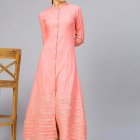 Long Kurtis Can Be Statement Pieces If You Know How to Style Them Properly! 10 Amazing Long Kurti Designs and How to Style Them in Different Ways (2020)
Long Kurtis Can Be Statement Pieces If You Know How to Style Them Properly! 10 Amazing Long Kurti Designs and How to Style Them in Different Ways (2020)
What Is A Saree?
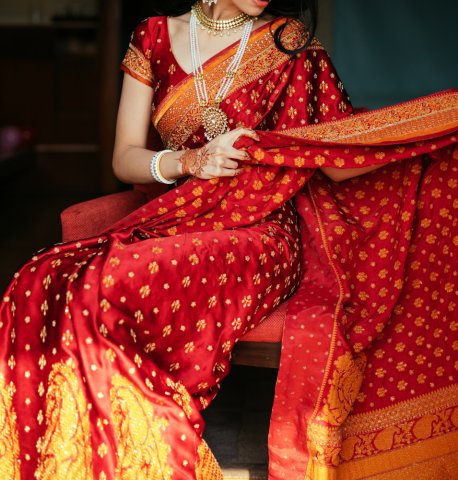
The saree is one of the most iconic and graceful Indian dress. It has been in existence for centuries and has references in “Mahabharata”, an ancient Indian epic. As time passes, there are many changes, which have taken place for saree draping style. you can carry a saree in different beautiful ways.
A saree is essentially a 5-yard or a 9-yard uncut and unstitched piece of fabric, elegantly draped over a woman’s body showcasing her curves elegantly. A saree is also considered an apt offering for goddesses in various Indian religions. The saree supports many weavers whose livelihood depends on this ancient and immortal garment.
How to Drape a Saree?
Draping a saree is an art that needs to be practised repeatedly to be perfected. A perfectly worn saree needs, very few to no safety pins. However, if you are a true beginner have copious amounts of safety pins. Though there are many different techniques for wearing a saree, the technique below is the most common one. The first step is to get everything ready (like safety pins, shoes and accessories) and wear your blouse and petticoat. Your petticoat should match your saree and should be tied firmly. Wear your heels as well. Now, follow the below steps to wear your saree perfectly.
- Tuck the correct end of the saree in the right-hand side of your petticoat. Bring the saree in a full circle tucking as you go. Leave a portion of the free end and tuck the remaining in the petticoat for now.
- Bring the pallu to the front and make pleats with your thumb and forefinger. Pin it to your left shoulder and arrange the pleats to your preference. Keep an eye on the length. You don't want it too short.
- Bring the pleats firmly to the right-hand side and let the temporarily tucked portion out. With the remaining saree make pleats as many as you can in the same way. Tuck it mid waist and pin it in.
- Keep an eye on the length, so that it doesn't get caught in your heels.
6 Tips to Shine in a Saree
Level it Appropriately
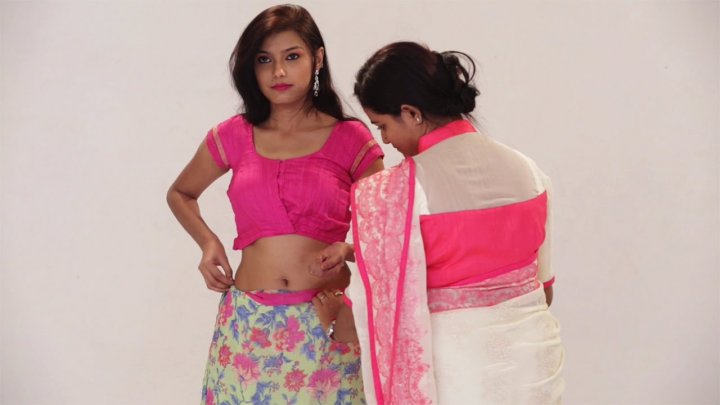
Where the saree starts and ends matters as much as the choice of the saree and the draping of the saree. Few pressure points to be noted are the length of the pallu, the placement of the pleats and the petticoat and the length of the saree itself.
- While you are concentrating on getting the pleats neat and tucked, you might miss on the pallu. So, first things before pinning the pallu, fix the length and then pin the pallu.
- If you are looking for a neat and elegant drape, make sure your petticoat is just 1 inch below the navel. Any lower or any higher, the drape loses its class. And the pleats should be tucked in at mid waist, if you go any more to the right, the tasteful drape gets a trashy look.
- Sarees need heels period! And the saree should just graze the ground and your toes should play peep and go as you walk. Maybe an inch higher. If you go higher the saree loses its elegance.
Pleat it Right
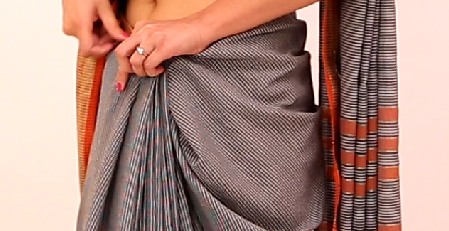
Saree is an unstitched piece of fabric which needs to be draped just right. The beauty and gracefulness of the drape come in the perfect pleats. The pleats differ depending on the type of fabric. If you are going for a flowy fabric like chiffon, the pleats can be thin, but if it’s anything grand and stiff like silk, it needs to be broad and neatly creased.
Pin it But Invisibly

The size and the colour of the pin also matter when wearing a saree. If you wear an all-around large pin not only is it visible, it also leaves pin marks on the saree damaging its integrity. You can use large pins on your pleats at your waist but use small and coloured pins otherwise.
Tuck it Clean
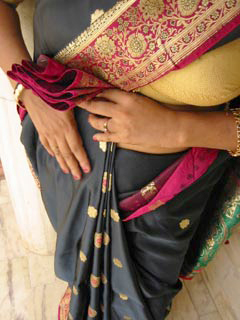
Are you someone who is forever in the fear of the saree loosening from the confines of the petticoat? In that case, make sure that you tuck everything inside the petticoat when you first make the full round. Maybe add a couple of safety pins. A couple more safety pins to lose your fear is worth it.
Match the Petticoat

Whatever saree you choose, make sure you match the petticoat to the saree. A straight, solid coloured petticoat never goes wrong. However, if you want to accentuate your waist you can get a fish cut petticoat stitched. But remember that it goes well only in the case of the net and see through sarees. For net sarees, you can also look for shimmery satin petticoats. It adds more elegance to the net saree. But give them a cotton lining, else it sticks to your leg as you walk.
Choose Appropriate Jewellery
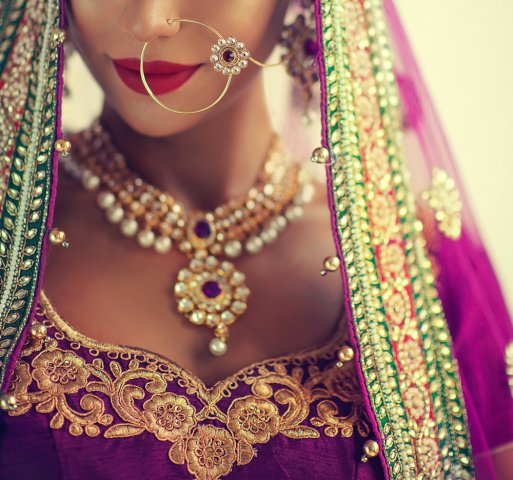
More is less when it comes to accessories for Indians. But apart from weddings or such functions, stay away from heavy accessories and let the saree sing. The saree in itself lends grace and elegance, that you will find minimal accessories work the best. But in the case of a wedding function, just go ahead and doll yourself up and let your mom smile.
10 Must Try Saree Draping Techniques
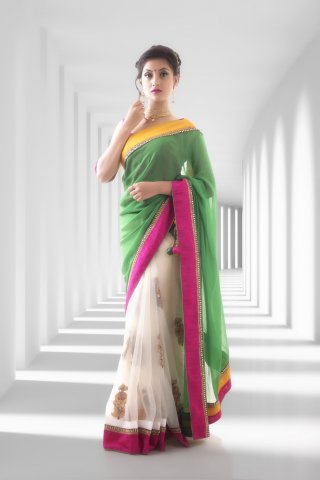
The western pull has also influenced the saree and it has evolved with the changing times as it always does and has gained widespread fame. Here are a few saree draping techniques from all over India and a couple with western influences too.
Traditional Saree Draping Techniques Worth Mastering
South India Style

Ideally, there are two ways your saree can be worn. South Indian style may be the classic draping style or Madisar or Koshavam (the way it is depicted below). Kanjeevaram is the best bet for wearing saree in this way. It shows the beauty of the saree and the zari work to its perfection. While the classic draping style requires the 5-yard saree, the Madisar or Koshavam requires a 9-yard saree.
- Wrap one meter of the fabric around you and make a knot around at mid-waist.
- Make pleats with the shorter end of the saree. Tuck one end of the pleats at the back by taking it between your legs. Move the rest of the pleats to your left-hand side and tuck it in the front.
- Bunch the rest of the saree and take it to the back again through your legs. Tuck the broad edge and bring the rest to the front
- Bring the pallu over the left side and drape it crosswise in the front and tuck it at the waist. Make sure the borders on the left and right side are the same length.
Marathi Style
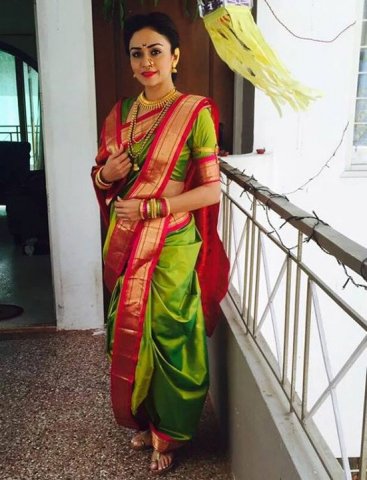
If you are looking for a style to highlight your curves and still stick to tradition, Marathi style is the one. It is also called the Nauvari style of draping and requires a 9-yard saree. Like the name indicates, the origin of this style of draping is Maharashtra.
- Begin draping the saree with it to your back and hold it to your left side. Leave about one yard of the saree to the left side and knot it at mid waist to your right side.
- Make small pleats, starting with the short edge of the slack end and tuck it at the back bringing it between your legs.
- Make pleats with the pallu and pin it on your left shoulder bringing under your right arm.
- With the remaining length, make pleats and tuck it at mid waist near the pleats.
- The saree lies an inch above your feet.
Gujarati Style
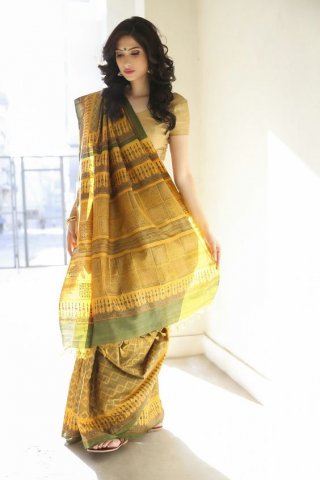
Have a comfortable saree with a really gorgeous pallu? It should also be slightly soft and not stiff. Bright colours with heavy embroidery works play well. Kanjeevarams and Banaras silks work well with this style of draping.
- Tuck the saree at the waist towards the right side and move the saree to the back, tucking it in the saree along the way.
- Bring the saree to the front to the left side and tuck it clean.
- Make pleats in the pallu and bring it to the front. The pallu flows from the back to front. Take one of the ends, drape it on your chest and bring it to the back. Secure it firmly.
- With the remaining saree left, make crisp and clean pleats and tuck it at mid waist.
Five Modern Twists to Saree Draping
Belted Style
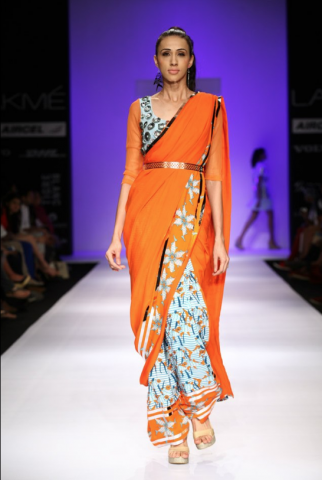
Belted saree drape is nothing new. Belted style has been there for ages with belly chains, kamarpatta, waist chains and hip chains. The classic style includes ornately carved belts predominantly in gold. The belted style is a modern take on the old classic with broad belts, thin belts, leather belts or even cloth belts cinching the saree to the waist. The belts keep the pleats in place giving a neat and sleek look.
Scarf Style
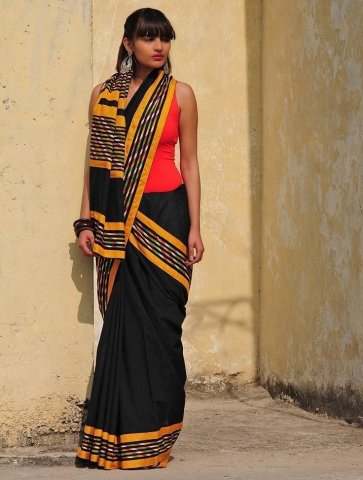
The scarf style of wearing a saree is an edgy twist to the classical way of wearing a saree. Drape the saree just as you do and instead of pinning the pleat to the shoulder wrap it around your neck just like a scarf. Chiffon or net sarees without much embellishment work perfectly for this style of draping.
Your blouse here should not be the traditional deep neck blouse. Go for a boat neck or even a halter neck and show off those awesome shoulders. Go ahead and accessorize it any way you want. Layer some chains and go for a hippy look or add a belt for a contemporary look.
Butterfly Style
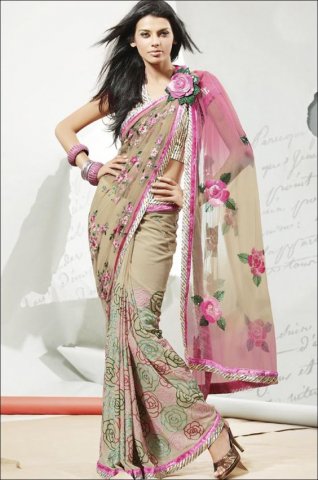
Butterfly style of draping a saree is a simple twist to the classic way of draping a saree. Here the pleats of the pallu are narrow and result in a slim column across your shoulder. A flowy fabric like net or georgette or chiffon works well for this style of draping. Silkier and embellished your saree is, more it resembles a butterfly. Also, this style requires your blouse and shoes to be ornate. This is much favoured by celebrities since it showcases a curvy body beautifully and exposes the midriff.
Fishcut Sytle
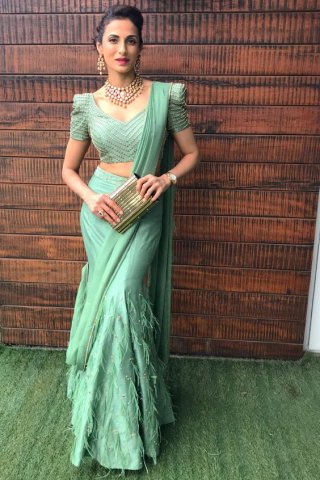
The fish cut style is more about the petticoat than about the saree. The fish cut style is rendered to the saree by the petticoat. The petticoat is fitted at the hip and waist and flares at the knees and below. This highlights your shape and if you have a hourglass figure, this is the one for you. The petticoats should be chosen with care and should be of materials silk, cotton or satin. The saree should also be of a silky, flowy material. You can play around with different materials with varying levels of embellishment but make sure your petticoat is fitted to your frame to achieve this style of draping.
Lehenga Saree
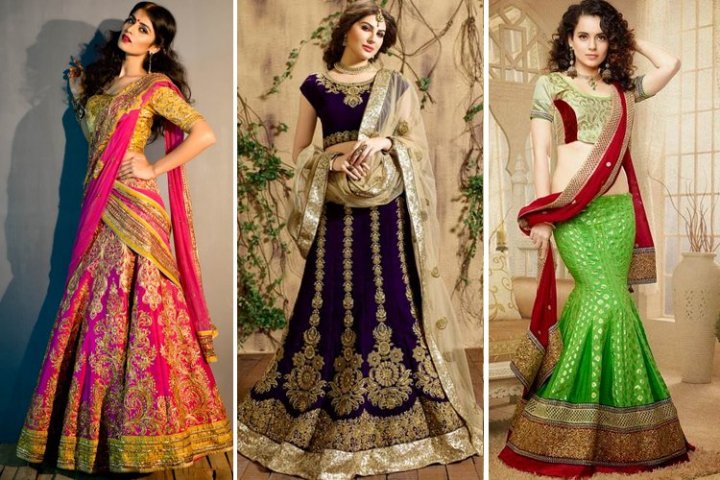
It’s your friend’s wedding and she has set a dress code to be a lehenga. But you don’t have one! Not to worry.You can drape your saree in the lehenga style. Use any flowy or silky material like net or chiffon. The way it is worn lets you experiment with adding a belt or flaunt an embellished blouse.
- Start with tucking the non-pallu end of the saree on your right waist and wrap it around your waist, front to back; tucking it all the way.
- Wrap it around your waist again and take it to the back.
- Bring it around to the front and make pleats in the pallu. Make sure the pleats are narrow.
- With the remaining fabric left, make pleats and tuck it at the back.
-
 The Elegance of Cotton Sarees is Evergreen: 10 Different Types Of Cotton Saree You Must Have in Your Wardrobe (2020)
The Elegance of Cotton Sarees is Evergreen: 10 Different Types Of Cotton Saree You Must Have in Your Wardrobe (2020)
-
 Wondering What to Wear To the Next Party? You Can Now Choose from These Top 10 Kurtis That Can Carry You Style Quotient to The Next Level!
Wondering What to Wear To the Next Party? You Can Now Choose from These Top 10 Kurtis That Can Carry You Style Quotient to The Next Level!
-
 Long Kurtis Can Be Statement Pieces If You Know How to Style Them Properly! 10 Amazing Long Kurti Designs and How to Style Them in Different Ways (2020)
Long Kurtis Can Be Statement Pieces If You Know How to Style Them Properly! 10 Amazing Long Kurti Designs and How to Style Them in Different Ways (2020)
-
 Rock the Latest Lehenga Trends: 10 Stylish Saree Lehenga Recommendations for a Scintillating Look (2020)
Rock the Latest Lehenga Trends: 10 Stylish Saree Lehenga Recommendations for a Scintillating Look (2020)
-
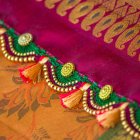 What is Saree Kuchu and How to Find the Perfect Saree Kuchu. 10 Must-Have Designs and Why You Should Use Them (2020)
What is Saree Kuchu and How to Find the Perfect Saree Kuchu. 10 Must-Have Designs and Why You Should Use Them (2020)
Be Elegant, Be Unique
There is no other garment except a saree which can be carry in so many beautiful styles. The one thing that you must keep in your mind is that whatever style you are carrying, it should suit your personality and the occasion. Also, before you step out, make sure you feel comfortable with how it's been draped and sits on you as it will be difficult to adjust once you arrive at your destination and if you're in discomfort, your saree is all you will be thinking about!









 Highlight the Best Facets of Your Incomparable Beauty: Discover the Best Face Highlighter Currently Available in India and Everything You Need to Know About Using Face Highlighters for Maximum Effect (2023)
Highlight the Best Facets of Your Incomparable Beauty: Discover the Best Face Highlighter Currently Available in India and Everything You Need to Know About Using Face Highlighters for Maximum Effect (2023)
 Forget the Blemishes and Get that Picture Perfect Flawless Radiance on Your Face: Check out the Best Foundations for Oily Skin Currently Available in India and Everything You Need to Know About Makeup Foundations (2023)
Forget the Blemishes and Get that Picture Perfect Flawless Radiance on Your Face: Check out the Best Foundations for Oily Skin Currently Available in India and Everything You Need to Know About Makeup Foundations (2023)
 Make Your Presence Felt Wherever You Go: Discover the Best Perfumes Under 2000 for Both Men and Women to Announce Your Arrival and Make Any Occasion Memorable (2023)
Make Your Presence Felt Wherever You Go: Discover the Best Perfumes Under 2000 for Both Men and Women to Announce Your Arrival and Make Any Occasion Memorable (2023)
 Protect Your Oily Skin from the Harmful Rays of the Sun: Discover the Best Gel Based Sunscreens for Oily Skin and Everything You Need to Know Before Buying One (2023)
Protect Your Oily Skin from the Harmful Rays of the Sun: Discover the Best Gel Based Sunscreens for Oily Skin and Everything You Need to Know Before Buying One (2023)
 Minor Blemishes and Wrinkles Affecting Your Confidence? Check out the Best BB Creams to Conceal Your Worries and Nourish Your Skin to Restore the Healthy, Radiant and Glowing Complexion Back Again (2023)
Minor Blemishes and Wrinkles Affecting Your Confidence? Check out the Best BB Creams to Conceal Your Worries and Nourish Your Skin to Restore the Healthy, Radiant and Glowing Complexion Back Again (2023)
